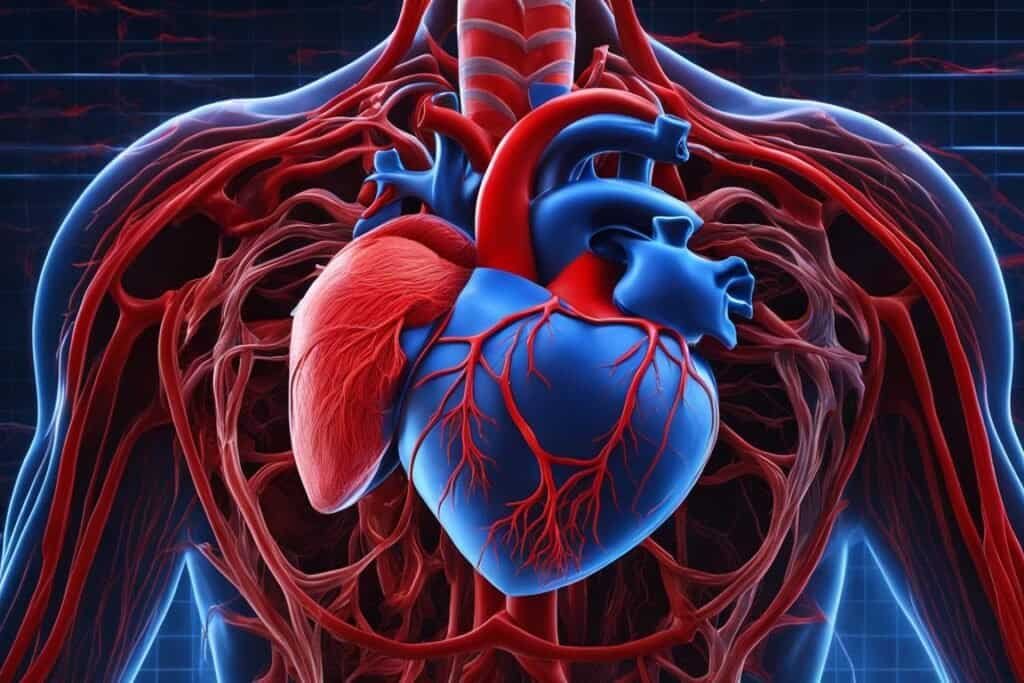Heart diseases are no longer just a concern for the older population. A concerning trend has emerged in recent years – an alarming rise in heart attacks among young Indians. Research indicates a 13% increase in sudden cardiac arrests among individuals in their mid-30s to mid-40s, signaling the need for a closer look at cardiovascular health among the younger generation.
Heart disease in Indians tends to occur at an earlier age compared to other populations, often without any warning signs. Sedentary lifestyles, diabetes, alcohol consumption, smoking, and hypertension have been identified as significant risk factors contributing to the rising incidence of heart attacks in young Indians. However, it is important to note that some individuals may not have any known risk factors, making preventive measures and regular check-ups all the more crucial.
Key Takeaways:
- Heart diseases are increasing among young Indians at an alarming rate.
- Sedentary lifestyles, diabetes, alcohol consumption, smoking, and hypertension are major risk factors for heart attacks in young Indians.
- Regular check-ups and awareness about sudden cardiac arrest are essential for prevention.
- Adopting a healthier lifestyle, including a balanced diet and exercise, can help reduce the risk of heart diseases.
- Early detection and intervention are crucial for better cardiovascular health in young Indians.
Factors Contributing to the Rise in Heart Attacks Among Young People in India
Several factors contribute to the increasing number of heart attacks among young people in India. Lifestyle choices play a crucial role in determining cardiovascular health, and unhealthy habits can significantly impact heart disease risk. Let’s take a closer look at the changing trends in heart attacks among young individuals in India:
- Sedentary Lifestyles: With the rise of technology and desk jobs, young Indians are leading increasingly sedentary lifestyles. Lack of physical activity can weaken the heart muscles, increase blood pressure, and elevate the risk of heart attacks.
- Unhealthy Diet Choices: The adoption of a Westernized diet high in processed foods, unhealthy fats, sugar, and sodium has become prevalent among young Indians. Such eating habits contribute to obesity, high cholesterol levels, and other heart disease risk factors.
- High Levels of Stress: The fast-paced, competitive work culture and societal pressures can lead to chronic stress among young Indians. Stress hormones can raise blood pressure and cholesterol levels, increasing the chances of heart attacks.
- Smoking: Tobacco use, including smoking, is a significant risk factor for heart disease. The harmful chemicals in tobacco can damage blood vessels, reduce oxygen supply to the heart, and promote the formation of blood clots.
- Excessive Alcohol Consumption: Binge drinking and excessive alcohol consumption can raise blood pressure, damage heart muscles, and contribute to irregular heart rhythms, all of which increase the risk of heart attacks.
The prevalence of heart diseases is increasing at a younger age in India compared to other countries, emphasizing the urgency to address these issues. By promoting awareness and implementing preventive measures, we can work towards ensuring better heart health among young Indians.
Symptoms and Causes of Sudden Cardiac Arrest
Sudden cardiac arrest can be a life-threatening condition that strikes without warning, bringing the heart to a sudden stop. It is crucial to be aware of the symptoms and causes associated with this cardiac event.
Symptoms of Sudden Cardiac Arrest
Sudden cardiac arrest can manifest through various symptoms, including:
- Chest discomfort
- Irregular heart palpitations
- Shortness of breath
- Weakness
- Lightheadedness
If you experience these symptoms, it is important to seek immediate medical attention, as they can be indicative of a potentially life-threatening situation.
Causes of Sudden Cardiac Arrest
Multiple factors can contribute to the occurrence of sudden cardiac arrest. These include:
- Sedentary lifestyle
- Smoking
- Excessive alcohol consumption
- Obesity
- Poor diet choices
Additionally, individuals with a family history of heart diseases or diabetes may have an increased risk of experiencing sudden cardiac arrest.
To lower the risk of sudden cardiac arrest, it is important to maintain a healthy lifestyle, make healthier choices regarding diet and exercise, and seek regular medical check-ups. Early detection and proper management of risk factors can significantly reduce the likelihood of sudden cardiac arrest.

Understanding the Mechanism of Sudden Cardiac Arrest
Sudden cardiac arrest occurs when the heart’s electrical system malfunctions, resulting in erratic heartbeats and the heart abruptly stopping its pumping function. These irregular heart rhythms, known as arrhythmias, can disrupt the heart’s normal rhythm and lead to a sudden loss of blood flow to the body’s vital organs.
Fluctuations in heart rate play a significant role in the occurrence of sudden cardiac arrest. When the heart rate is either too slow or too fast, it can disrupt the heart’s normal electrical signals and initiate potentially fatal arrhythmias. The irregular patterns can cause the heart to fibrillate or quiver instead of contracting effectively, significantly compromising its ability to pump blood.
The ejection fraction (EF) is a crucial indicator of heart health and plays a role in sudden cardiac arrest. It measures the percentage of blood pumped out of the heart’s main pumping chamber, the left ventricle, with each heartbeat. A healthy EF is typically above 50%, indicating efficient blood circulation. However, an EF below 35% significantly increases the risk of sudden cardiac arrest, as the heart’s pumping function is significantly impaired.
Medical procedures such as cardiac catheterization and echocardiogram can help assess heart function and identify potential risks of sudden cardiac arrest. Cardiac catheterization allows doctors to examine the coronary arteries and evaluate blood flow, while an echocardiogram provides detailed images of the heart’s structure and function, including the ejection fraction.
The Role of Heart Rate Fluctuations
Heart rate fluctuations are essential in maintaining the normal rhythm and function of the heart. Regular heartbeats between 60 to 100 beats per minute ensure efficient blood circulation, delivering oxygen and nutrients to the body’s tissues.
When the heart rate becomes irregular, it can interrupt this vital process. A heartbeat that is too slow (bradycardia) can deprive the body of sufficient oxygen, causing weakness, dizziness, and potentially leading to fainting episodes. Conversely, a heart rate that is too fast (tachycardia) can impair the heart’s ability to effectively pump blood, resulting in symptoms such as palpitations, shortness of breath, and chest discomfort.
Heart rate fluctuations also play a significant role in arrhythmias that can trigger sudden cardiac arrest. Abnormal heart rhythms such as ventricular fibrillation or ventricular tachycardia can lead to the heart’s sudden cessation of normal pumping function, depriving the body of blood flow and vital oxygen.
It is crucial to monitor heart rate regularly, especially for individuals at higher risk of sudden cardiac arrest, such as those with a history of heart disease or certain cardiac conditions. Detecting and managing heart rate fluctuations promptly can help reduce the risk of sudden cardiac arrest and improve overall heart health.
Ejection Fraction: A Crucial Indicator of Heart Health
Ejection fraction (EF) is a valuable clinical measure that assesses the heart’s ability to pump blood. It is determined by comparing the amount of blood pumped out of the left ventricle with each heartbeat to the total amount of blood in the ventricle just before contraction. A healthy ejection fraction typically ranges from 50% to 70%, indicating efficient blood circulation.
Low ejection fraction values, particularly below 35%, indicate impaired heart function and an increased risk of sudden cardiac arrest. A reduced ejection fraction often occurs as a result of heart conditions such as heart failure, coronary artery disease, or a previous heart attack. Monitoring ejection fraction is vital in identifying individuals at higher risk of sudden cardiac arrest and determining appropriate treatment and intervention strategies.

| Heart Rate Fluctuations | Ejection Fraction |
|---|---|
|
|
Precautionary Measures for Heart Attack Prevention in Young People
Preventing heart attacks in young people requires adopting a healthier lifestyle and taking precautionary measures. By following a few simple steps, you can reduce the risk of heart disease and promote better cardiovascular health.
1. Maintain a Balanced Diet
Eating a well-balanced diet is essential for maintaining a healthy heart. Include plenty of fruits, vegetables, whole grains, and lean proteins in your daily meals. Limit the consumption of saturated fats, trans fats, and added sugars. A heart-healthy diet can help manage weight and lower cholesterol levels, reducing the risk of heart attacks.
2. Engage in Regular Exercise
Regular physical activity is crucial for a healthy heart. Aim for at least 30 minutes of moderate-intensity exercise on most days of the week. This can include activities such as brisk walking, jogging, cycling, or swimming. Exercise helps strengthen the heart muscles, improves blood circulation, and promotes overall cardiovascular fitness.
3. Avoid Smoking and Excessive Alcohol Consumption
Smoking and excessive alcohol consumption are detrimental to heart health. Smoking damages blood vessels, increases blood pressure, and reduces oxygen supply to the heart. Alcohol, when consumed in moderation, may have some health benefits, but excessive consumption can lead to high blood pressure, increased cholesterol levels, and heart disease. Quitting smoking and drinking in moderation can significantly lower the risk of heart attacks.
4. Manage Stress Levels
Chronic stress can contribute to the development of heart disease. Find healthy ways to manage stress, such as practicing relaxation techniques, engaging in hobbies, spending time with loved ones, or seeking professional help if needed. Taking steps to reduce stress can have a positive impact on your heart health.
5. Regular Check-ups
Regular check-ups with a healthcare professional are crucial for early detection and prevention of heart problems. Schedule regular appointments with a cardiologist to monitor your heart health. They can assess your risk factors, recommend appropriate tests, and provide personalized guidance on preventive measures.
6. Be Aware of Family History and Genetic Predispositions
It’s important to be aware of any family history of heart disease or genetic predispositions. If you have a family history of heart problems, inform your healthcare provider. They can conduct additional tests and recommend preventive measures tailored to your specific needs.
Consult a Cardiologist
If you have concerns about your heart health or any risk factors, consult a cardiologist. They can provide expert guidance, prescribe appropriate medications if necessary, and help you develop a personalized plan to prevent heart attacks.
Remember, preventive measures and a healthy lifestyle are key to ensuring a strong and healthy heart. Taking care of your heart today will protect your well-being in the long run.
Conclusion
The alarming rise in heart attacks among young people in India is a cause for concern. Heart diseases are now occurring in individuals at a younger age, often without any early signs or symptoms. The sedentary lifestyle, poor dietary choices, high stress levels, and unhealthy habits prevalent among young adults contribute significantly to this increasing incidence of heart attacks.
To prevent heart attacks in young people, it is essential to adopt preventive measures. Maintaining a healthy lifestyle, including regular exercise and a balanced diet, is crucial. Avoiding smoking and excessive alcohol consumption, managing stress levels, and getting regular check-ups also play a significant role in mitigating the risk of heart attacks. Furthermore, being aware of family history and genetic predispositions can aid in taking proactive steps towards better cardiovascular health.
Early detection and intervention are vital in preventing heart diseases among young Indians. By staying proactive, maintaining a healthy lifestyle, and having regular check-ups, it is possible to reduce the risk of heart attacks significantly. Together, we can work towards creating a healthier future for young people in India, where heart diseases become less prevalent and individuals can lead long, fulfilling lives.

